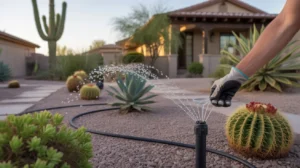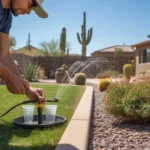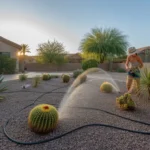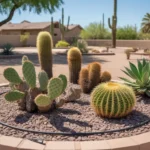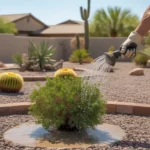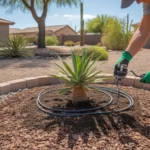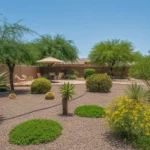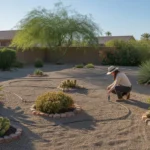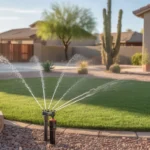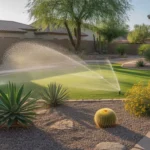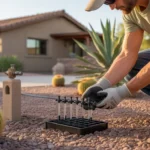Summertime in Gilbert brings longer days, triple-digit temperatures, and the need to navigate the city’s evening watering restrictions. From May 1 through September 30, Gilbert residents are prohibited from operating landscape irrigation systems or hose-end sprinklers between 10 am and 6 pm. While these restrictions are in place to conserve water during the hottest months, they can present challenges for keeping your yard healthy and hydrated. With a little know-how and some smart strategies, you can maintain a thriving landscape while being a responsible water steward.
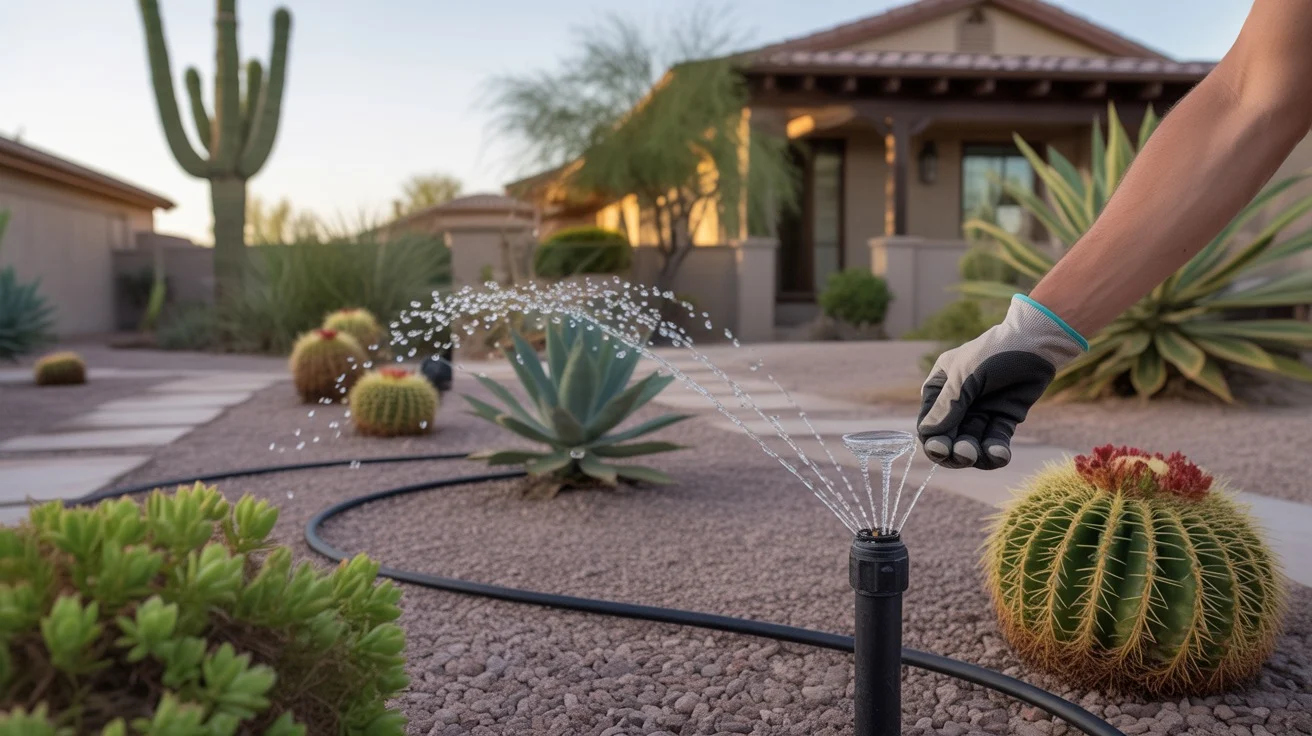
Understanding Gilbert’s Watering Restrictions
Gilbert’s summer watering restrictions are part of the city’s ongoing efforts to promote water conservation and reduce evaporation losses during peak daytime hours. From May through September, outdoor watering is prohibited between 10 am and 6 pm. This applies to all landscape irrigation systems, including sprinklers, bubblers, and drip emitters. Hand watering with a hose is allowed any time, as long as it’s attended and not left running unattended.
The reasoning behind the daytime restriction is simple: watering during the hottest hours of the day leads to significant evaporation losses. In the intense Arizona sun, much of the water sprayed onto plants and grass can evaporate before it even reaches the soil. By shifting watering to the cooler morning and evening hours, more of that precious water can soak into the ground and be used by your plants’ roots.
Violating the watering restrictions can result in a warning or fines, so it’s important to adjust your irrigation controller’s schedule accordingly. Most modern controllers allow you to set multiple start times, so you can split your watering into shorter cycles in the early morning and evening hours. This not only complies with the restrictions but also allows the water to penetrate more deeply and evenly.
Making the Most of Evening Watering
While the morning hours just before 10 am are ideal for watering, the evening window from 6 pm to 10 pm can also be an effective time to hydrate your yard. The key is to water deeply and efficiently to avoid wasting water or creating overly soggy conditions overnight.
One smart approach is to use a drip irrigation system to deliver water slowly and directly to the root zones of your plants. Drip systems minimize evaporation and runoff by applying water at a very low flow rate, usually through small emitters placed at the base of each plant. You can run drip zones for longer periods in the evening without overwatering, as the water has time to soak in deeply overnight.
If you have grass areas, consider breaking up your evening sprinkler cycles into shorter intervals spaced an hour apart. This allows the water to penetrate more evenly and avoids creating puddles or runoff. For example, instead of running your grass zones for 15 minutes straight, try three 5-minute cycles separated by an hour each. Most sprinkler controllers allow you to set multiple start times to achieve this.
Avoiding Common Evening Watering Pitfalls
While evening watering can be an effective solution during the summer restrictions, there are a few potential drawbacks to keep in mind. Watering too late in the evening or applying too much water overnight can lead to fungal growth, as the grass stays damp for an extended period. It’s best to finish your evening irrigation cycles by 8 pm to give the grass time to dry off a bit before nightfall.
Another issue to watch for is overwatering with drip systems. Because the flow rate is so low, it’s easy to assume you need to run the system for hours on end. However, this can lead to waterlogged soil and unhealthy plants. A good rule of thumb is to water long enough to moisten the root zone (usually 6-12 inches deep), then let the soil partially dry out before watering again. Use a soil moisture probe or dig down a few inches to check the soil before running your drip zones again.
Finally, be extra vigilant about checking for leaks, clogs, or misaligned sprinkler heads during the evening restriction period. Small issues can waste a lot of water if they occur overnight when you’re not around to spot them. Inspect your system regularly and make repairs promptly to avoid costly water bills and damage to your yard.
Adjusting Your Yard Care Routine
Adapting to Gilbert’s summer watering restrictions may require some tweaks to your overall yard care routine. Mowing your grass in the evening, right after the 6 pm watering window opens, can help conserve moisture and reduce stress on the grass blades. Aim to mow no more than 1/3 of the grass height at a time, and keep your mower blades sharp for clean, healthy cuts.
Mulching your garden beds can also help retain moisture and reduce the need for frequent evening watering. A 3-4 inch layer of organic mulch, like shredded bark or compost, slows evaporation from the soil surface and moderates soil temperatures. Just be sure to keep the mulch a few inches away from the base of trees and shrubs to avoid trapping too much moisture against the trunk.
During the peak of summer, it’s also wise to limit fertilizing and avoid heavy pruning, as both can stimulate tender new growth that requires more water. If you need to fertilize, opt for a slow-release, organic formula that won’t shock the plants with a sudden dose of nutrients. Save major pruning tasks for the fall or winter months when the plants are less stressed.
Planning Ahead for Monsoon Season
While summer in Gilbert is mostly hot and dry, the arrival of monsoon season can bring intense bursts of rainfall. These storms can quickly saturate the soil, especially if you’ve been watering deeply in the evenings. To avoid overwatering during monsoons, consider investing in a rain sensor that automatically shuts off your irrigation system when a certain amount of rainfall is detected.
It’s also a good idea to check your drip emitters and sprinkler heads before monsoon season to make sure they’re clear of debris and in good working order. Clogged or broken emitters can lead to uneven watering and stressed plants. While you’re at it, take a look at your gravel beds and make sure they’re graded properly to prevent washouts during heavy rains.
By staying on top of your irrigation system’s performance and adjusting your watering schedule as needed, you can navigate Gilbert’s summer watering restrictions with ease. With a little extra attention and some smart strategies, your yard can thrive all season long while still conserving that precious desert water. Remember, the key is to water deeply and efficiently in the evening hours, while still allowing time for the plants and grass to dry out a bit overnight. By working with nature’s rhythms and being a responsible water user, you can keep your corner of the desert looking its best all summer long.

